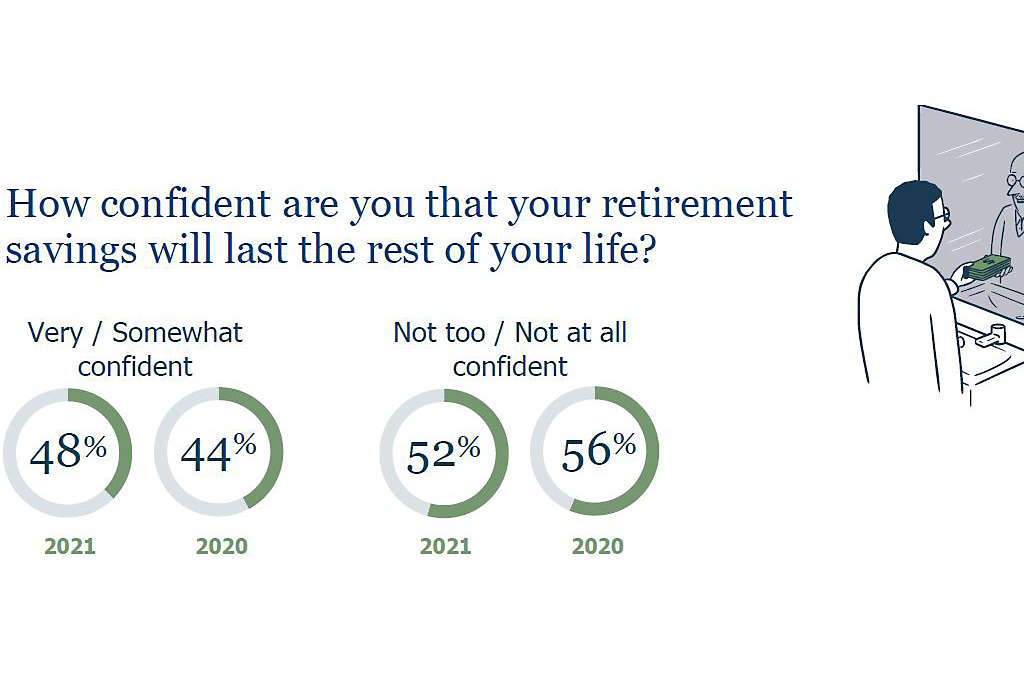ARTICLE
A year of financial uncertainty…and hope.

This year, Americans have experienced a wide range of emotions and circumstances in so many areas of their lives—including their finances. In the wake of social, political, and economic upheaval catalyzed and exacerbated by the COVID-19 pandemic, people’s financial habits, sentiments, and goals have certainly changed – but how much?
As part of an effort to understand Americans’ financial goals, preparedness, and feelings about their ability to create secure financial futures, New York Life recently launched the New York Life Wealth Watch, a recurring survey that provides a real-time pulse on the state of finances in America. This inaugural survey builds on a deep bench of research previously conducted by New York Life. The newly-released results highlight trends that emerged during the past year as a result of the COVID-19 pandemic.
The survey of a national sample of 2200 adults found people feeling cautiously optimistic. Compared to last year, Americans feel more confident in their ability to meet their short-term financial goals—such as their ability to pay their monthly bills, maintain their savings, and make needed or desired purchases.
Amid these financial sighs of relief, some trepidation remains. Long-term goals, including paying off student loan debt, retiring on-time, and affording a down payment on a home still feel out of reach to many.
The pandemic economy forced Americans to focus on their short-term financial goals
Last March, amid job losses, stock market shifts, and changing lifestyles, Americans felt uncertainty regarding their finances. A year later, things have stabilized, and Americans are more confident in their ability to pay their monthly bills (73% confidence in March 2021 vs. 53% confidence in March 2020). Of the adults who reported short-term financial goals of paying for a vacation or paying off credit card debt, 66% and 62%, respectively, now feel confident in their ability to afford these goals.
A majority (67%) of adults reported that they received a stimulus check to supplement their income in the past year. Nearly half of respondents (45%) put this extra income most often toward daily expenses.
However, the focus on near-term expenses only added strain to the long-term financial outlook. More than half of respondents (53%) stopped or reduced their student debt payments during COVID-19, and half of these respondents shifted the money previously allocated to student loan payments towards daily living expenses (49%). Only 35% of adults who indicated paying off student debt as a goal are confident in their ability to do so.
Confidence in retirement savings, which was low prior to the pandemic, remains low a year later, with a majority of Americans (52%) having little to no confidence that their retirement savings could last their lifetimes.

But with some stability restored in the short-term, now is the time to start looking ahead.
Millennials are ready to take control of their financial futures
While pandemic-prompted financial uncertainty has affected all age groups, Millennials’ interest in seeking guidance from a financial professional distinguishes them from other generational cohorts. Forty percent of Millennials indicated that COVID-19 has made them more likely to seek assistance from a financial professional when updating their financial strategies, compared to only 24% of all adults.
Millennials stand out from other generations with a higher focus on seeking guidance from financial professionals and feeling confident about managing debt.
- 40% indicated that COVID-19 has made them more likely to seek assistance from a financial professional when updating their financial strategy, as opposed to only 24% of U.S. adults indictating so.
In general, Millennials report slightly higher levels of confidence than the average adult in their ability to meet long-term goals, including paying off student debt, credit card bills, medical debt, car financing, and other personal loans. Interestingly, Millennials are also twice as likely as the average adult to be saving to start their own businesses in the near future (18% vs. 9%).
Perhaps more than any other generation, Millennials may be ready and willing to assert control over their short- and long-term financial goals, and it is critical for this generation to develop a strategy that can help them achieve their goals.

More Americans feel confident in their ability to buy a home
At the start of the pandemic, most Americans did not feel confident in their ability to purchase a home—nor did they feel that buying a home was a relevant piece of their financial strategies. One year and one suburban housing boom later, things have changed. Now, 31% of adults feel confident in their ability to buy a home (compared to 13% in March 2020), with only 37% reporting that buying a home is not a relevant financial goal (vs. 60% in March 2020).
Sentiments regarding home-buying reveal demographic differences. More so than the average adult, Millennials indicated that they are saving up for a down payment on a home (25% vs. 14%). In general, Hispanic, Black, and Asian-American respondents expressed more confidence in their ability to buy a home (29% of white respondents vs. 41% of Hispanic respondents, 38% of Black respondents, and 37% of Asian-American respondents*).
In a year that has exposed inequity across all facets of society, equal access to financial tools and planning, regardless of age, gender, or ethnicity, is an important priority of ours.
Looking Ahead
Life looks different today than it did last year, and things may never return to pre-pandemic “normalcy.” A year after the start of the pandemic, we see promising glimpses of financial optimism, even as most adults still stress the need for long-term planning and security.
If the pandemic has proved anything, it’s that nothing is certain and being prepared is important. Understanding your financial strategy and priorities can make a material difference down the road to provide protection should challenging circumstances arise. By defining and working toward your goals, with the help of a trusted financial professional, Americans can instill a level of stability and peace of mind that can withstand whatever may lie ahead.
To learn more, visit the Research hub on the Newsroom.
SURVEY METHODOLOGY
This poll was conducted between March 19-March 24, 2021 among a national sample of 2,200 adults. The interviews were conducted online and the data were weighted to approximate a target sample of adults based on gender, educational attainment, age, race, and region. Results from the full survey have a margin of error of plus or minus 2 percentage points.
1NB: AAPI responses are not included due to the AAPI respondent sampling number being statistically insignificant.
*Footnote: Asian-American respondent findings are directional in nature, due to a sample size of 62 and a margin of error of plus or minus 12 percentage points.
RELATED CONTENT
Go back to our newsroom to read more stories.
Media contact
Sara Sefcovic
New York Life Insurance Company
(212) 576-4499
Sara_M_Sefcovic@newyorklife.com
